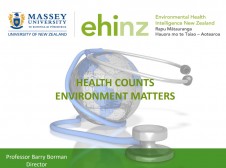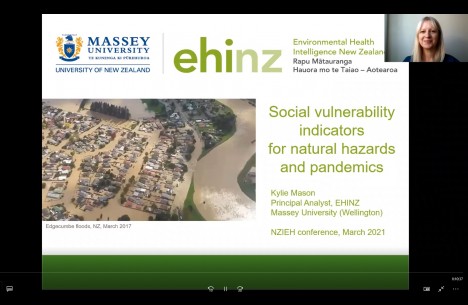Reports, articles, presentations
Explore our published journal articles, reports and some of our presentations.
On this page:
Journal articles
Mason K, Kelly L, Jackson C, Read D, Borman B. (2022). Did new treatments contribute to a decrease in melanoma deaths? New Zealand Medical Journal, 135(1558): 90-95.
Mason K, Lindberg K, Haenfling C, Schori A, Marsters H, Read D, Borman B. (2021). Social vulnerability indicators for flooding in Aotearoa New Zealand. International Journal of Environmental Research and Public Health, 18(8):3952. doi: 10.3390/ijerph18083952.
Mason K, Lindberg K, Read D, Borman B. (2018). The importance of using public health impact criteria to develop environmental health indicators: The example of the indoor environment in New Zealand. International Journal of Environmental Research and Public Health, 15, 1786.
Briggs D, Mason K, Borman B. (2016). Rapid assessment of environmental health impacts for policy support: The example of road transport in New Zealand. Int J Environ Res Public Health, 13(1): 61.
Mason, K.M. & Borman, B. (2016). Burden of disease from second-hand smoke in New Zealand. New Zealand Medical Journal, 129 (1432), 16-25.
Borman B, Poynter M. (2014). When enough is not enough: folic acid fortification in New Zealand. New Zealand Medical Journal 127(1399): 83-84.
Tisch C, Pearson A, Kingham S, Borman B, Briggs D. (2013). Environmental health indicators: a review of initiatives worldwide. Management of Environmental Quality An International Journal 01/2014; 25:446-466. doi: 10.1108/MEQ-11-2012-0075
Reports
![]() Social vulnerability to the impacts of climate-related hazards (Aug 2024) (pdf, 9.54 MB),
Social vulnerability to the impacts of climate-related hazards (Aug 2024) (pdf, 9.54 MB), ![]() Appendix 4 - Heatmaps of social vulnerability indicators by territorial authority (pdf, 397 KB)
Appendix 4 - Heatmaps of social vulnerability indicators by territorial authority (pdf, 397 KB)
This report presents national results for individual social vulnerability indicators for New Zealand, including changes over time, maps by territorial authority, and differences by key population groups where possible. The social vulnerability indicators mostly draw on 2013 and 2018 Census data. This report was commissioned by the Climate Change Commission, and informed their first national adaptation plan progress report.
![]() Air Quality and Social Inequity in Aotearoa: A preliminary assessment (November 2023) (pdf, 2.5 MB)
Air Quality and Social Inequity in Aotearoa: A preliminary assessment (November 2023) (pdf, 2.5 MB)
This report investigates social inequity of air quality exposure (particulate matter - PM2.5, and nitrogen dioxide - NO2) and associated impacts in New Zealand. Analyses are presented by socioeconomic deprivation (NZDep2013), ethnic group, urban areas, and district health boards. This report made use of the HAPINZ 3.0 model, and was written by Lou Wickham, Jayne Metcalfe (Emission Impossible Ltd), and Kylie Mason (EHINZ).
![]() Heatwaves and Mortality: A pilot study for the Canterbury district (September 2023) (pdf, 1.2MB)
Heatwaves and Mortality: A pilot study for the Canterbury district (September 2023) (pdf, 1.2MB)
This report investigates three different heatwave definitions, and estimates the impact of heatwaves on mortality in the pilot study area of Canterbury district (formerly Canterbury District Health Board, CDHB). This pilot study covers the study period of November-March 2000 to 2018.
![]() The Burden of Disease from Second-hand Smoke in New Zealand (July 2016) (pdf, 0.6 MB)
The Burden of Disease from Second-hand Smoke in New Zealand (July 2016) (pdf, 0.6 MB)
This report estimates the number of deaths and healthy years of life lost (DALYs) due to second-hand smoke exposure in New Zealand in 2006 and 2010.
![]() Occupational Disease Surveillance Report, 2000-2013 (Jan 2015) (pdf, 0.6 MB)
Occupational Disease Surveillance Report, 2000-2013 (Jan 2015) (pdf, 0.6 MB)
This report presents findings on the prevalence of occupationally related diseases and conditions in New Zealand between 2000-2013.
![]() Potential for Ground Water Bores to meet Lower Hutt's Emergency Water Needs after Large Earthquakes - GNS Science Report (Nov 2014) (pdf, 5.8 MB)
Potential for Ground Water Bores to meet Lower Hutt's Emergency Water Needs after Large Earthquakes - GNS Science Report (Nov 2014) (pdf, 5.8 MB)
This report presents the potential for water bores in case of a large earthquake affecting Lower Hutt. We co-authored this report with GNS and Cutriss Consultants.
Hazardous substances
![]() National Hazardous Substances and Lead Notifications January - December 2017 (Jul 2018) (pdf, 0.8 MB)
National Hazardous Substances and Lead Notifications January - December 2017 (Jul 2018) (pdf, 0.8 MB)
This report presents findings from the Hazardous Substances Disease and Injury Reporting Tool (HSDIRT) in 2017
![]() National Hazardous Substances and Lead Notifications January - December 2016 (Jul 2017) (pdf, 0.8 MB)
National Hazardous Substances and Lead Notifications January - December 2016 (Jul 2017) (pdf, 0.8 MB)
This report presents findings from the Hazardous Substances Disease and Injury Reporting Tool (HSDIRT) in 2016
![]() National Hazardous Substances and Lead Notifications January - December 2015 (July 2016) (pdf, 0.7 MB)
National Hazardous Substances and Lead Notifications January - December 2015 (July 2016) (pdf, 0.7 MB)
This report presents findings from the Hazardous Substances Disease and Injury Reporting Tool (HSDIRT) in 2015.
![]() National Hazardous Substances and Lead Notifications January - December 2014 (January 2016) (pdf, 0.7 MB)
National Hazardous Substances and Lead Notifications January - December 2014 (January 2016) (pdf, 0.7 MB)
This report presents findings from the Hazardous Substances Disease and Injury Reporting Tool (HSDIRT) during 2014.
![]() National Hazardous Substances and Lead Notifications January - December 2013 (February 2015) (pdf, 0.6 MB)
National Hazardous Substances and Lead Notifications January - December 2013 (February 2015) (pdf, 0.6 MB)
This report presents findings from the Hazardous Substances Disease and Injury Reporting Tool (HSDIRT) and EpiSurv during 2013.
![]() Annual Hazardous Substances Injury Report 2017 (December 2017) (pdf, 1.1 MB) This report presents findings on the adverse health effects of exposure to hazardous substances in New Zealand in 2017.
Annual Hazardous Substances Injury Report 2017 (December 2017) (pdf, 1.1 MB) This report presents findings on the adverse health effects of exposure to hazardous substances in New Zealand in 2017.
![]() Annual Hazardous Substances Injury Report 2016 (December 2016) (pdf, 1.1 MB)
Annual Hazardous Substances Injury Report 2016 (December 2016) (pdf, 1.1 MB)
This report presents findings on the adverse health effects of exposure to hazardous substances in New Zealand in 2016.
![]() Annual Hazardous Substances Injury Report 2015 (January 2016) (pdf, 1.1 MB)
Annual Hazardous Substances Injury Report 2015 (January 2016) (pdf, 1.1 MB)
This report presents findings on the adverse health effects of exposure to hazardous substances in New Zealand in 2015.
![]() Annual Hazardous Substances Injury Report 2014 (November 2014) (pdf, 1.1 MB)
Annual Hazardous Substances Injury Report 2014 (November 2014) (pdf, 1.1 MB)
This report presents findings on the adverse health effects of exposure to hazardous substances in New Zealand in 2014.
![]() Annual Hazardous Substances Injury Report 2013 (May 2014) (pdf, 1.1 MB)
Annual Hazardous Substances Injury Report 2013 (May 2014) (pdf, 1.1 MB)
This report presents findings on the adverse health effects of exposure to hazardous substances in New Zealand in 2013.
![]() Survey of Low Cost Cosmetics (Lipstick) (Mar 2011) (pdf, 166 KB)
Survey of Low Cost Cosmetics (Lipstick) (Mar 2011) (pdf, 166 KB)
This report presents findings of a study investigating chemicals in low-cost lipsticks. Some lipsticks were found to have leachable cadmium, chromium and lead. All samples complied with levels of arsenic, mercury and leachable antimony.
![]() Survey of Low Cost Cosmetics (Hair Dye) (Mar 2011) (pdf, 127 KB)
Survey of Low Cost Cosmetics (Hair Dye) (Mar 2011) (pdf, 127 KB)
This report presents findings of a study investigating chemicals in low-cost hair dyes. All samples tested for the presence of meta-, ortho- and para-phenylenediamines complied with the current Cosmetic Products Group Standard.
Presentations
'Health counts, environment matters'
Presentation given by Professor Barry Borman, at the New Zealand Institute of Environmental Health (NZIEH) Annual Professional Development Conference, March 2021
This presentation gives an overview of the work of Environmental Health Intelligence NZ (EHINZ) in monitoring the effect of the environment on human health. The EHINZ team aims to produce "information for public health action" for a wide range of stakeholders and clients across the health-related sectors.
'Social vulnerability indicators for natural hazards and pandemics'
Presentation given by Kylie Mason, at the New Zealand Institute of Environmental Health (NZIEH) Annual Professional Development Conference, March 2021
This talk describes a set of social vulnerability indicators for natural hazards that we have developed for New Zealand. These indicators are a valuable tool for understanding which population groups are more vulnerable to the negative impacts of natural hazards, and where they live.


